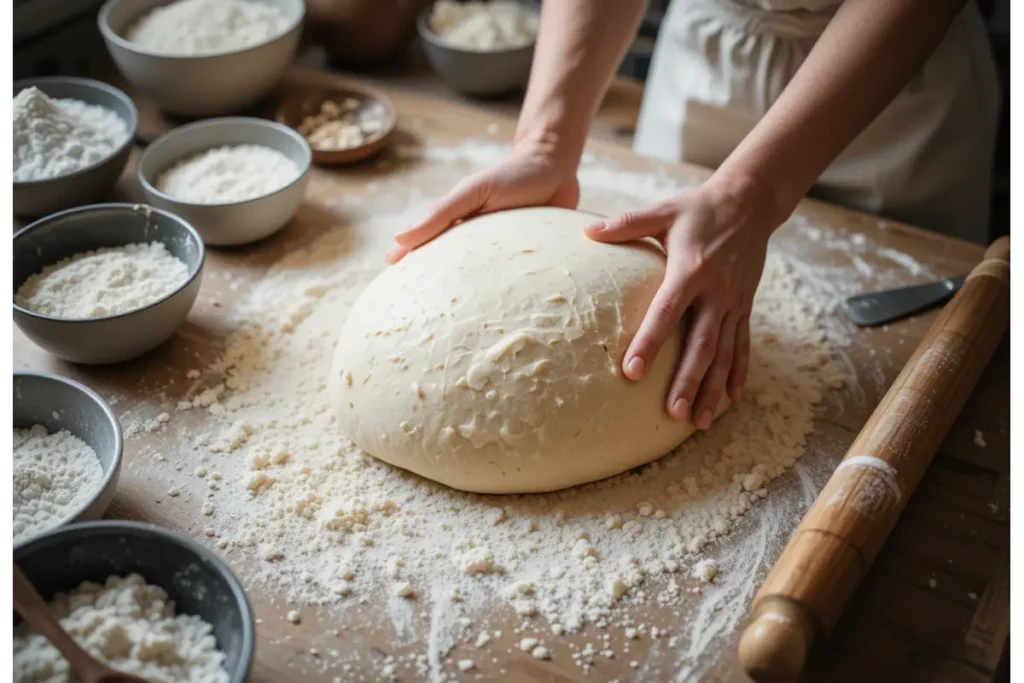Is All Sourdough Bread Gluten-Free?
Sourdough bread, a culinary favorite for its distinct tangy flavor, chewy texture, and health benefits, holds a special place in kitchens worldwide. But for those adhering to a gluten-free diet due to celiac disease, gluten intolerance, or health-conscious choices, the question arises: is sourdough bread gluten-free? This article unpacks the truth behind sourdough bread’s gluten content, its production process, risks, and how you can enjoy safe alternatives. Dive in to discover everything you need to know about sourdough bread and gluten-free living, including a simple gluten-free bread recipe to try at home.
Table of Contents
What Does Gluten-Free Really Mean?
The term “gluten-free” goes beyond a simple label. Gluten is a structural protein found in grains like wheat, barley, and rye. It provides elasticity and chewiness to baked goods. For most people, gluten poses no problem. However, for individuals with gluten intolerance or celiac disease, consuming gluten—even in minute amounts—can trigger severe reactions, such as:
- Digestive Distress: Bloating, gas, and abdominal pain.
- Systemic Inflammation: Leading to fatigue, joint pain, and long-term complications.
- Immune Response (Celiac Disease): Damage to the small intestine and nutrient absorption issues.
Gluten-free diets aim to eliminate these risks by avoiding all sources of gluten. Certified gluten-free products adhere to strict standards, often ensuring less than 20 parts per million (ppm) of gluten—considered safe for most individuals with gluten sensitivity.
If you’re searching for a curated list of gluten-free breads, check out our Best Gluten-Free Bread: A Comprehensive Guide for expert recommendations.
Understanding Sourdough Bread Production
Sourdough bread sets itself apart with its unique fermentation process. Traditional bread relies on commercial yeast for leavening, while sourdough uses a combination of wild yeast and lactic acid bacteria. This natural process enhances the bread’s flavor and texture while slightly altering its nutritional profile.
Key Elements of Sourdough Fermentation:
- Wild Yeast and Lactic Acid Bacteria: Break down carbohydrates and partially digest proteins like gluten.
- Extended Fermentation: Reduces phytic acid (an antinutrient) and may lower gluten levels slightly.
- Ingredients: Traditional recipes often call for wheat, rye, or barley flour, all of which naturally contain gluten.
The critical takeaway is that while fermentation may reduce gluten levels, it does not eliminate gluten entirely in traditional sourdough bread.
Is Sourdough Bread Gluten-Free?
The straightforward answer is no—not all sourdough bread is gluten-free. However, this depends on the type of sourdough being consumed:
1. Traditional Sourdough Bread
Traditional sourdough bread is typically made with gluten-containing grains such as wheat, rye, or barley. Even though fermentation breaks down some of the gluten, trace amounts remain. This makes traditional sourdough unsuitable for individuals with celiac disease or severe gluten sensitivity.
2. Gluten-Free Sourdough Bread
Gluten-free sourdough bread uses alternative flours like rice, sorghum, or almond. These flours contain no gluten, and when processed in certified gluten-free environments, the bread is safe for consumption. Gluten-free sourdough retains the tangy flavor and chewy texture while ensuring no health risks for gluten-intolerant individuals.
The Science of Fermentation and Gluten Reduction
Fermentation is a transformative process that affects gluten in bread. During fermentation, enzymes in the wild yeast and bacteria partially break down gluten proteins into smaller fragments. This process may make sourdough bread easier to digest for some individuals who are not strictly gluten-free.
However, fermentation cannot remove gluten entirely. Research suggests that the gluten content in traditional sourdough bread remains too high for people with celiac disease, who must avoid gluten entirely. Gluten-free sourdough bread bypasses this issue by using flours that are naturally gluten-free.
Benefits of Sourdough Bread
Both traditional and gluten-free sourdough bread offer several advantages over commercially baked bread. Here’s why sourdough is cherished:
1. Improved Digestibility
The fermentation process breaks down complex carbohydrates, making sourdough easier to digest than regular bread. Some individuals with mild gluten sensitivity report fewer symptoms when consuming sourdough compared to other bread types.
2. Nutrient-Rich Profile
Sourdough is packed with probiotics, B vitamins, and essential minerals like magnesium and zinc. Fermentation reduces phytic acid, improving the bioavailability of these nutrients.
3. Unique Flavor and Versatility
Its signature tangy taste and chewy texture elevate meals, whether used for sandwiches, avocado toast, or alongside soups and salads.
For more health and nutritional value of sourdough bread, check out this link.
Risks of Consuming Traditional Sourdough Bread
While sourdough bread has undeniable benefits, it poses significant risks for individuals sensitive to gluten:
Trace Gluten Content: Even in fermented wheat bread, gluten is not completely broken down during the fermentation process. Consuming it can lead to adverse effects in people with celiac disease or gluten intolerance, potentially triggering severe health issues.
Cross-Contamination: Gluten-free sourdough made in shared facilities may be contaminated with gluten, posing a serious risk for those with strict gluten-free dietary requirements. Cross-contamination can occur during processing, packaging, or even ingredient storage.
Misleading Labels: Some products are labeled as “low-gluten” or “sourdough-style,” which can mislead consumers into thinking they are safe for gluten-free diets. It’s crucial to verify certifications and ingredient lists to ensure the product is truly gluten-free.
Hidden Ingredients: Sourdough recipes often include additives or other flours that may contain gluten, such as barley malt or rye flour, further complicating safety for gluten-sensitive individuals.
Variation in Fermentation Processes: The effectiveness of fermentation in reducing gluten varies widely based on preparation methods, starter cultures, and fermentation duration. This inconsistency makes it unreliable for those with strict gluten-free needs.
Risk of Miscommunication: In restaurants or bakeries, sourdough bread may be incorrectly promoted as gluten-free due to common misconceptions about its fermentation process, leading to unintentional exposure.
Delayed Symptoms: For some individuals with gluten sensitivity or celiac disease, symptoms from consuming sourdough bread might not appear immediately, making it harder to pinpoint the source of exposure.
To ensure safety, individuals with gluten sensitivities should opt for sourdough bread explicitly certified gluten-free and produced in dedicated gluten-free facilities.
How to Choose Gluten-Free Sourdough Bread
To safely enjoy sourdough bread on a gluten-free diet, it’s important to follow specific guidelines to ensure your choice aligns with your dietary needs. Gluten-free sourdough bread can be a delightful and safe option when prepared and sourced properly, providing the familiar tangy flavor and chewy texture of traditional sourdough without the gluten. Here’s how to make sure your selection is both safe and delicious:
1. Verify Gluten-Free Certification
First and foremost, look for products clearly labeled as “Certified Gluten-Free.” Certification ensures that the bread has been tested and meets strict standards for gluten content, typically less than 20 parts per million (ppm). This label provides peace of mind, especially for individuals with celiac disease or severe gluten sensitivities. When shopping, prioritize brands or bakeries that display this certification prominently on their packaging.
2. Scrutinize Ingredient Lists
Reading the ingredient list is crucial to ensure the bread is made with gluten-free flours, such as rice flour, almond flour, sorghum flour, or tapioca starch. Avoid products containing wheat, barley, rye, or any derivatives, as even small traces can cause adverse reactions for those with gluten intolerance. Additionally, watch out for ambiguous terms like “natural flavors” or “starch,” which may sometimes contain hidden gluten unless specified otherwise.
3. Inquire About Production Practices
When buying sourdough bread from local bakeries or smaller producers, don’t hesitate to ask detailed questions about their production practices. Specifically, inquire about cross-contamination risks, as gluten-free bread may be prepared in facilities that also handle wheat-based products. For extra precaution, opt for bakeries that use dedicated gluten-free equipment and workspaces to avoid contamination.
4. Opt for Trusted Brands
Choosing reliable and well-reviewed gluten-free bread brands is another way to ensure safety and quality. Brands with a strong reputation for producing gluten-free products often have rigorous testing and production standards in place. For recommendations, consult our Best Gluten-Free Bread: A Comprehensive Guide, which highlights top-rated options that meet both taste and dietary requirements. These trusted brands make it easier to enjoy sourdough without worry.
5. Try Homemade Options
For those who love baking, making your own gluten-free sourdough bread is an excellent alternative. Using a gluten-free starter and carefully chosen flours like millet or buckwheat allows you to control every aspect of the process, ensuring no gluten sneaks into your recipe. Homemade bread also gives you the freedom to experiment with flavors and textures, tailoring the loaf to your personal preferences.
6. Stay Educated and Informed
Lastly, staying informed about the latest gluten-free baking trends and products is key to enjoying sourdough safely. Join online gluten-free communities, follow trusted recipe blogs, and keep up with new certifications and brands entering the market. Knowledge empowers you to make the best choices for your health while still indulging in your favorite foods.
By following these detailed guidelines, you can enjoy the unique taste and texture of sourdough bread while adhering to your gluten-free diet. Whether you’re buying from trusted brands, experimenting with homemade recipes, or researching production practices, these steps will help you make informed decisions and savor every slice with confidence.
Gluten-Free Bread Recipe: Make Your Own at Home
If you’re ready to enjoy fresh, gluten-free bread, try this simple and delicious recipe.

Ingredients:
- 2 cups gluten-free all-purpose flour
- 1 tsp baking powder
- 1 tsp baking soda
- 1 tsp salt
- 2 tbsp sugar or honey
- 1 ½ cups buttermilk (or dairy-free alternative)
- 1 egg (or flaxseed substitute for vegan)
- 2 tbsp olive oil or melted butter
Instructions:
- Preheat Oven: Set your oven to 375°F (190°C) and grease a loaf pan.
- Mix Dry Ingredients: In a large bowl, combine the gluten-free flour, baking powder, baking soda, salt, and sugar.
- Combine Wet Ingredients: In another bowl, whisk together the buttermilk, egg, and olive oil.
- Form the Dough: Gradually mix the wet ingredients into the dry mixture until a smooth dough forms.
- Transfer to Pan: Pour the dough into the prepared loaf pan and smooth the top with a spatula.
- Bake: Place the pan in the oven and bake for 40–50 minutes, or until a toothpick inserted in the center comes out clean.
- Cool: Let the bread cool in the pan for 10 minutes before transferring it to a wire rack.
Enjoy your gluten-free bread with your favorite spreads or as a base for sandwiches!
FAQs About Sourdough Bread
Q: Is sourdough bread safe for people with celiac disease?
A: Only gluten-free sourdough is safe. Traditional sourdough contains gluten and should be avoided.
Q: Does fermentation remove all gluten?
A: No, fermentation reduces gluten levels but does not eliminate it in wheat-based sourdough bread.
Q: What’s the difference between traditional and gluten-free sourdough?
A: Gluten-free sourdough uses alternative flours and is processed in gluten-free environments to prevent contamination.
Conclusion
Sourdough bread is a beloved staple with numerous health benefits, but not all varieties are gluten-free. Traditional recipes made with wheat, rye, or barley flour remain unsafe for those with celiac disease or gluten intolerance. However, gluten-free sourdough provides a safe and flavorful alternative, combining the benefits of fermentation with gluten-free ingredients.
By choosing certified gluten-free products or baking your own at home, you can enjoy sourdough’s tangy taste and health perks without compromising your dietary needs. Try our gluten-free bread recipe or explore our Best Gluten-Free Bread: A Comprehensive Guide to embark on your gluten-free journey with confidence!

